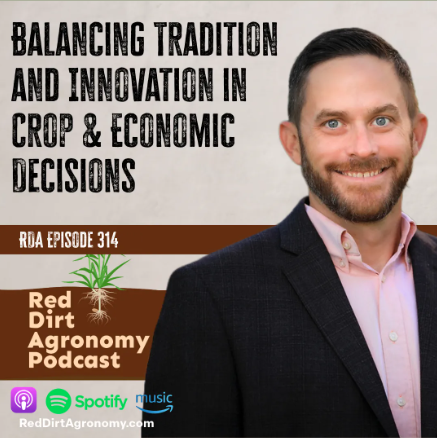
In this episode of the Red Dirt Agronomy Podcast, OSU Associate Professor of Agricultural Economics Dr. John Michael Riley acknowledges that producers often grapple with the choice of sticking to historical planting practices versus adapting to current market conditions; however, he says that understanding input costs and market prices is crucial for making informed decisions that can impact profitability.
Oklahoma producers tentatively began planting wheat for winter grazing in mid-August, but due to persistently dry conditions and the onslaught of army worms, minimal emergence was seen. However, the biggest concern is the price difference for those needing to plant wheat for grain. Low wheat prices, relatively cheap anhydrous, and rumors that nitrogen prices could skyrocket by springtime have grain farmers planning their next moves carefully.
“The risk for putting in dry wheat in August is a shallow rain that germinates the seed, but doesn’t sustain the plant,” Dr. Riley said. “It can sit there for a long time dry if that doesn’t happen. There are a lot of things producers do by the calendar, no matter what the environmental conditions are.”
Dr. Riley mentioned that there are risk management options, but many producers don’t take full advantage of them. He said that grazing cattle on wheat is a good start, though. “We can have that dual crop with wheat and cattle,” he commented. “That gives you a little bit of insulation in one or the other. Right now, the cattle market is pretty strong. That may entice some folks to go a little heavier on wheat so they have the capacity to run some cattle.”
Price protection through crop insurance and basic budgeting to minimize expenses are two other risk management options. He also said that creating a detailed budget is essential for producers. It outlines expected costs and revenues, enabling them to make informed agricultural decisions and manage their resources effectively.
After determining their budget, producers should determine whether or not they are comfortable with the price they are getting today.
“If you are comfortable with the price, lock it down, and don’t think about it anymore.” Dr. Riley advised. “Don’t beat yourself up if a better price comes tomorrow. Be comfortable in the fact that if the price moves in the other direction, you’ve got that covered. Have a price in mind, and once that price is there, try to secure – not all of it – but try to capitalize on it as much as possible.”
He observed that producers are more educated than they were 20 or 30 years ago and that technological advancements are readily available to lessen the effects of mistakes. Besides equipment advancements, markets are much more readily accessible to producers nowadays.
He admitted that it is easy to get caught in the trap of too much information. He said, “You have to make your budget, find your break-even, and work off of that. You have to have that conviction of once you make a decision, you can’t beat yourself up about it. Hindsight is 20/20 and you can’t let yourself get lost looking in the rearview mirror.”
Producers have to focus on the things they have some element of control over: land, soil nutrients, equipment and the frequency of use of it, and seed variety. Producers have the most control over the production of their products.
“The risk management comes in doing the job of producing the crop to the best of your ability,” Dr. Riley concluded. “If you are doing that correctly and budgeting correctly, to me, they are on the right foot.”
He said that mistakes are often made by trying too much on the marketing side. It’s important to stay on the right side of the fence of hedging versus speculating when it comes to futures marketing.
The Red Dirt Agronomy Podcast team discussed many other topics with Dr. Riley. Listen to the entire episode here.

















